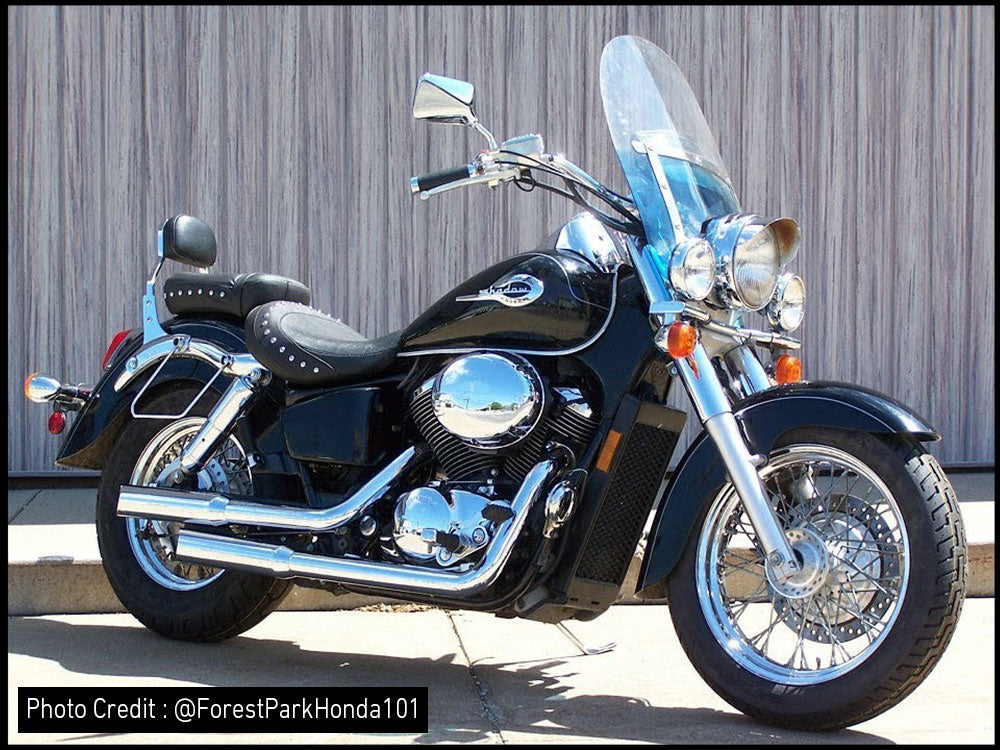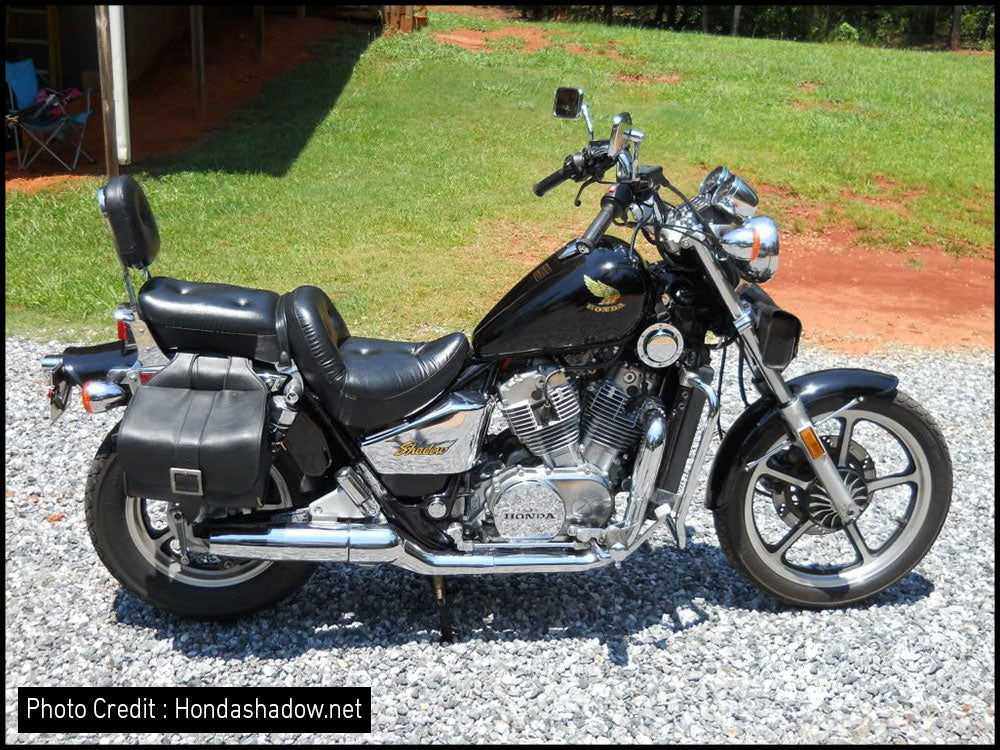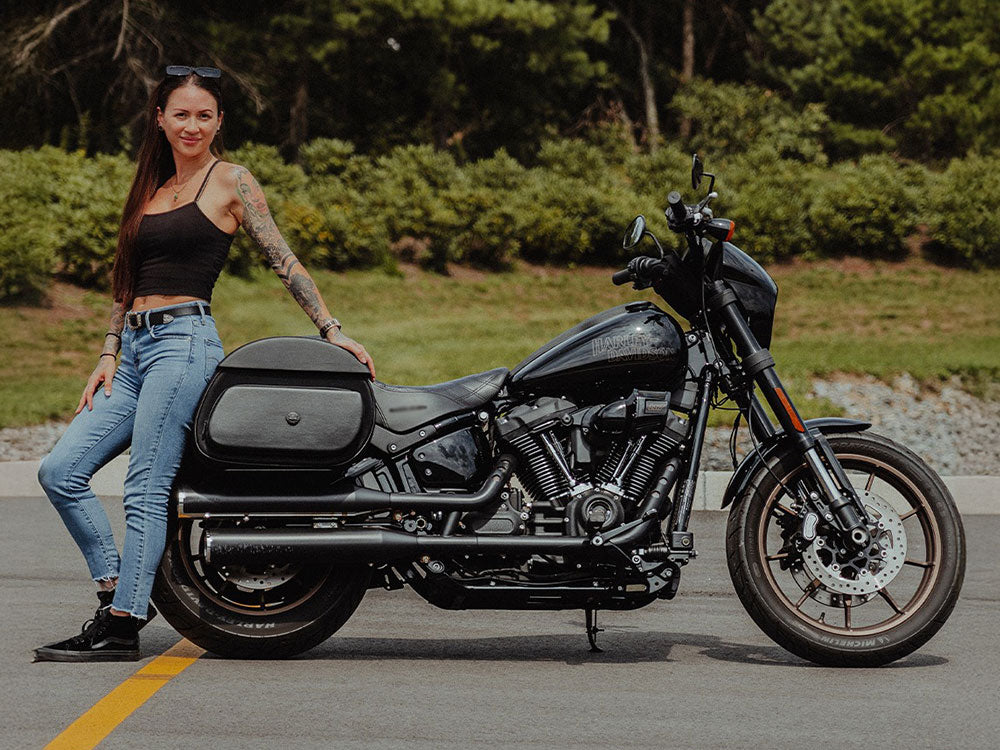Table of Content
Motorcycle riding has always been a habit of those who love to discover uncharted motorcycle roads and destinations. But to make these soul-satisfying trips possible, you will need a motorcycle first. Not just a random one, but a special motorcycle that can provide you comfort while traveling on long highways.
When talking about the best cruiser motorcycles, the Honda 750 Shadow Ace is no exception. In the past , when other companies had high standards with a big price bracket, Honda came up with a middleweight American Classic Edition motorcycle that could fulfill riders’ demands at a comparatively low cost.
In this article, we’ll be discussing specifications, background, performance, and more about the Honda 750 Shadow Ace.
1. A Brief History of Honda 750 Shadow Ace
Honda produced the (Shadow) VT750c in 1983. However, shortly after its release, the United States put import limits on Japanese motorcycles with displacements of more than 700 ccs, ostensibly to prevent manufacturers from competing with domestic V-twins. This resulted in Honda developing the VT700c.
Honda's Ace , or American Classic Edition, Shadow V-twin cruiser motorcycles were designed to compete with Harley-Davidson motorcycles. In 1998, the company introduced the Ace for the 750 cc class. Honda produced this model in two versions during its lifespan: the VT750CD Shadow A.C.E. Deluxe and the VT750C base model. The Ace 750 series was discontinued in 2003 and Honda replaced it with the Shadow 750 Aero.
However, the restrictions were eventually eased and the 750 was reintroduced in 1985. It was only around for a few years before being superseded by an 800 cc variant in 1988.
The Honda Shadow Ace 750 was not reintroduced into Honda's cruiser lineup until 1997. Since then it has gone by many names, including Spirit, Aero, RS, and Phantom.
Honda introduced a budget-friendly middleweight cruiser motorbike in 2001 for riders who don't want to maneuver around the city on a big bike. This bike was similarly built to provide riders with a powerful yet fuel-efficient machine.
Even though the Honda 750 Ace has a modest displacement, it does not necessarily imply compromises. The Shadow Ace, on the other hand, features Honda's legendary craftsmanship and dependability.
Initially, the Honda 750 Shadow was powered by a 583 cc engine from the Shadow VLX 600. To increase displacement to 745 ccs, the bore was enlarged from 4.0 mm to 79 mm and the stroke was lengthened from 10 mm to 76 mm.
Much of the 600 engine's power, feel, and rpm were carried over since Honda claimed that combining a larger flywheel effect from a heavier AC generation with the longer stroke resulted in low power, feel, and rpm. The valve size, duration, lift, and carburetor size, on the other hand, were given a different design .
Of course, many engine components, including its look, were altered. The 750 has two plugs per cylinder and a 9.0:1 compression ratio rather than the 600's 9.2:1. It also gets a new emissions-control system that injects air into the exhaust ports to ensure that the exhaust gases are completely burned. The most significant alteration is in the driveline, where the 750 gains a fifth transmission ratio while the transmission remains a wide-ratio system.
The Honda 750 Ace's chassis was substantially redesigned from the 600. The 750 uses a pair of shocks with chrome enclosures instead of the 600's single-damper hard-tail rear end. On forged frame components, a big rectangular-section swingarm pivots. 41 mm fork tubing, supported up by a brace, gives strength towards the front behind the chrome cover.
The machine's wide appearance begins with a large 120/90-17 front tire mounted on a wire-spoke wheel. The big front fender, seven-inch spotlight, long broad 3.7-gallon tank, wide solo saddle, full rear fender, and 170/80-15 rear tire all help it to reverse . A 180 mm brake drum is spoked to the rear wheel. A two-piston caliper in the front applies friction to an 11.7-inch disc. And on highway motorcycle rides, the disc has a solid carrier, making it hard to use a disc lock.
The Ace 750 was Honda's best styling effort to date, based on its remarkable features. The Honda 750 Shadow Ace was initially available in two models: one in the United States and one in Europe. The location of the speedometer was the only notable difference between the two variants. The white-faced electronic speedometer on the 750 Ace in the United States is positioned near the wide, pulled-back handlebar, which is clamped atop rubber-mounted risers.
The speedometer is mounted atop the fuel tank in the European version of the 750 Ace, giving the tank a bit more weight. The speedometer and associated warning lights are substantially closer to the rider's line of sight in the United States. The surprising chrome shroud around the gas cap is secured by hardware-store variety screws, which is a very un-Honda-like slip.
The passenger saddle can be removed, giving the bike an even longer and lower appearance. Honda designers paid special attention to the details, resulting in a lovely new stretched-out headlamp appearance. The first billet-style footpegs and rear fender rails ever installed on a mass-produced cruiser. The metal on the cast pegs has a dull surface that begs to be polished and chromed. Thanks to the rubber rings, there is traction around the pegs. The large circular airbox on the right side of the engine sparked significant debate because it was made of plastic. The shroud around the steering head, as well as the side panels, are made of plastic as well.
Aside from the ordinary 750 Ace, Honda also offered a Deluxe 750 Ace with chrome steel upper fork leg covers, chrome engine casings, chain guard, and foot controls.
Deeply balanced fenders, laced rims, a big headlight, and plenty of chromed features, including the hefty two -into-one exhaust and a classic heritage design, are all present in the 2003 Honda 750 Standard Ace.
2. Honda 750 Shadow Ace at First Glance

The year is 2022 and it has been 38 years since the first Honda Shadow 750 was released. After 39 years of manufacturing various configurations, it's safe to assume that the Shadow is a motorcycle stalwart that won't be going away anytime soon - especially since the second-hand market is thriving.
Classic cruiser styling includes a hefty tank, elegant contours, a low seat, and chrome components to complete the look. (For a more modern look, blacked-out versions are also available.) A Shadow's presence provides the appearance that it is a much larger machine than it actually is. There is enough to get around town and on lengthy interstate drives. When compared to other V-twin engines, engine vibrations are modest.
There are no obnoxious ergonomics to contend with because of the comfortable riding position. The upright, self-assured position for seeing the way ahead is great for learning riders. Riding two-up is no problem; the pillion has enough room and should be quite comfortable. It's simple to handle, predictable, and won't battle you as you try to get to where you want to go. Honda's legendary dependability factor is imprinted in the vehicle. At every level of their development, new models have been reasonable and competitively priced, making them accessible to a large audience. The used market is hopping and there are plenty of good deals to be grabbed.
3. Honda 750 Shadow Ace: A Buyer’s Guide
3.1 What is the Honda Shadow 750 Top Speed?
The 745 cc engine of the later Honda Shadow models produces 45 horsepower, allowing for a top speed of 95 mph.
3.2 What Size is the Honda Shadow Ace?
Honda used steel tubing to construct the 750 Ace frame. The 750 Ace has a length of 96.7 inches and a wheelbase of 63.6 inches thanks to this platform.
3.3 How Many Years Do Honda Shadows Last?
On average, a well-maintained Honda Shadow can last 15 years. Although 15,000 miles is considered significant mileage for these models, it's not uncommon to see units with over 30,000 miles when stored indoors over the winter. On average, a well-maintained Honda Shadow can last 15 years. Although 15,000 miles is considered significant mileage for these models, it's not uncommon to see units with over 30,000 miles when stored indoors over the winter.
4. Honda 750 Shadow Ace Specifications
4.1 Engine & Drive Train
| Type | Liquid-cooled, 52-degree tandem V-twin |
| Valve Arrangement | SOHC, 2 intakes, 1 exhaust valve per cylinder, operated by rockers, screw-type adjusters |
| Displacement, Bore x Stroke | 754cc, 79 x 76 mm |
| Carburetion | 2, 34 mm, Keihin CV |
| Compression Ratio | 9.0:1 |
| Lubrication | Wet sump, 3.1 qt., spin-on filter |
| Minimum Fuel Grade | 87 octane |
| Transmission | Wet multiple clutches 5 speeds |
| Final Drive | Chain, 41/17 |
4.2 Chassis
| Wheels | Wire-spoke, 17 x 3.00 front, 15 x 3.50 rear |
| Front Tire | 120/90-17 Bridgestone Exedra tube-type |
| Rear Tire | 170/80-15 Bridgestone Exedra tube-type |
| Front Brake | 11.6-in. disc, dual-piston caliper |
| Rear Brake | Drum, rod operated |
| Front Suspension | 41mm stanchions, 5.1-in. travel |
| Rear Suspension | Dual dampers, 3.5-in. travel, adjustment for pre-load |
| Fuel Capacity | 3.7 gal. (0.9 gal. reserve) |
| Handlebar | 33.4 in. wide, 1.0 in. diameter |
| Inseam Equivalent | 32.4 in. |
4.3 Performance
| Fuel Mileage | 37-49 mpg. 43.4 mpg ave. |
| Average Range | 161 miles |
| RPM at 60mph, top gear | 3360 |
4.4 Electrical and Instrumentation
| Charging Output | N/A |
| Battery | 12v, 14 AH |
| Forward Lighting | 55/60 watt, 7.0-in. headlight, position lights |
| Taillight | 1 bulb |
| Instruments | Speedometer, LCD odometer/trip meter, warning lights for neutral, high beam, oil pressure, turn signals, side stand, coolant temperature |
5. Aftermarket Parts and Luggage Options for Honda 750 Shadow Ace
Although Honda has stopped producing the 750 Shadow Ace, there are still many riders who cherish the ancient beauties. However, the model has grown outdated and newer variants with enhanced technology and features are now available.
If it's your bike though and you want to maintain its new look and appeal, you can always customize it to your preferences and riding comfort. Nothing is more convenient than installing a sissy bar to keep your back relaxed if you frequently go on long tours. For camping and one-day outings, you can mount a luggage bag to carry your supplies.
Furthermore, there are a variety of alternatives available to give your bike a gorgeous appearance. However, many riders admire the bike's antique look and want to retain its stock as a timeless icon. Attaching a pair of high-quality motorcycle saddlebags to your bike will allow you to carry your daily belongings.













Leave a comment
All comments are moderated before being published.
This site is protected by hCaptcha and the hCaptcha Privacy Policy and Terms of Service apply.